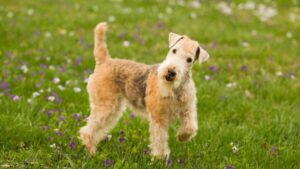
The Lakeland Terrier
Explore the fascinating history, character, and unique traits of the Lakeland Terrier, a breed shaped by necessity and determination.
Home » Dog Breeds » Lakeland Terrier Dog Breed
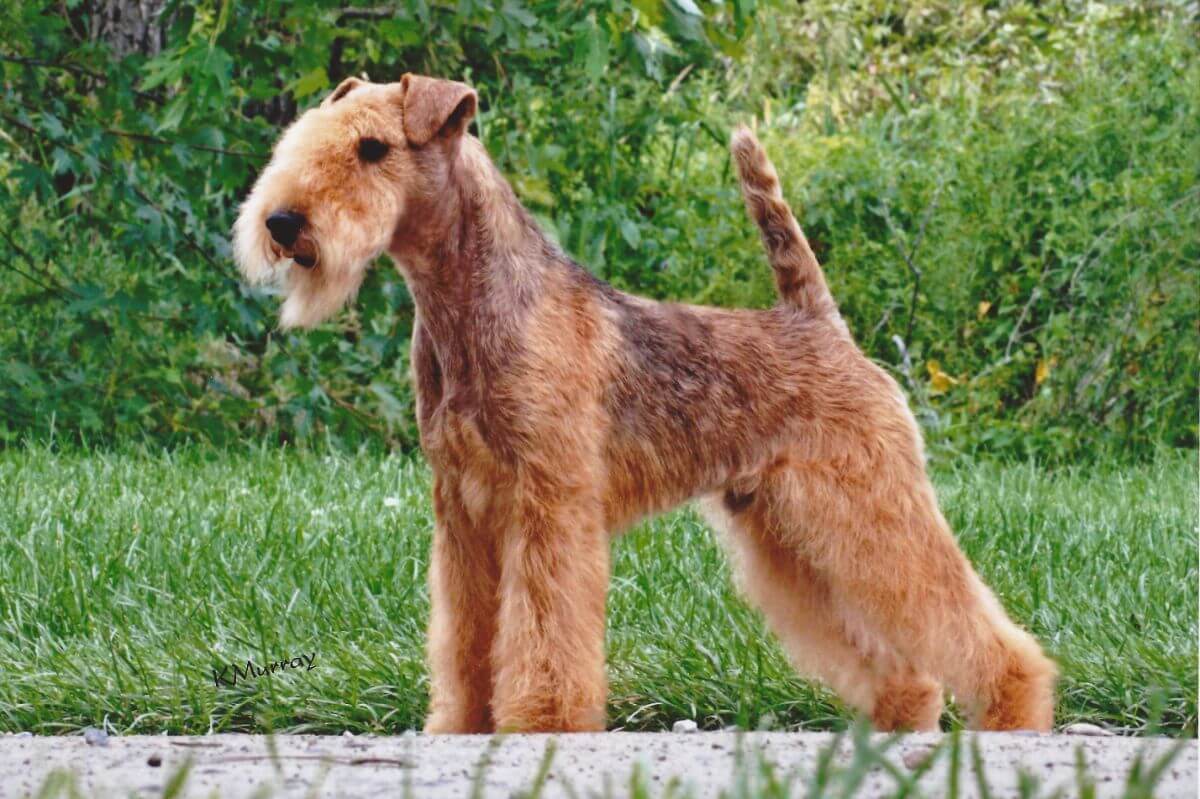

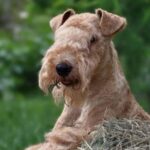

The Lakeland Terrier is a small, sturdy, and spirited breed, known for its distinctive appearance and bold personality. Originating from the Lake District in England, this breed was initially developed to protect sheep from predatory foxes and other vermin. Despite its compact size, the Lakeland Terrier possesses a strong and confident presence, embodying the tenacity and courage characteristic of a much larger dog. This breed’s adaptability and affectionate nature make it a beloved companion in homes and an enthusiastic competitor in various dog sports.
Terrier
14.5 – 15 inches
17 pounds
12 – 15 years
| Country of Origin | England |
|---|---|
| Bred For | Hunting, Companionship |
| Known For | Confidence, Affection, Friendliness |
| Popularity | Low |
| Temperament | Friendly, Confident, Bold |
| Activities | Hunting, Running, Walking, Conformation Shows, Dog Sports |
The Lakeland Terrier boasts a rich heritage that traces back to the rugged and picturesque Lake District of England. Originating from the region’s early terrier breeds, the Lakeland was developed to assist farmers in protecting sheep from predators like foxes, demonstrating remarkable courage and tenacity despite its small size. These early terriers were adept at navigating the rocky terrain and narrow crevices, traits that are still admired in the breed today.
The Lakeland Terrier’s ancestors likely include the now-extinct Old English Black and Tan Terrier, along with contributions from other terrier breeds such as the Bedlington Terrier and Border Terrier, which helped refine the Lakeland’s size, coat, and color. The breed was initially known for its working capabilities, but it also gained popularity in dog shows, with breeders refining its appearance for the show ring without compromising its working abilities.
Official recognition of the breed came in the early 20th century, with The Kennel Club in the UK registering the Lakeland Terrier in 1921. The breed’s charm and prowess soon caught the attention of dog enthusiasts in other countries, including the United States, where the American Kennel Club granted recognition to the Lakeland Terrier in 1934.
Throughout its history, the Lakeland Terrier has maintained its reputation as a fearless and lively companion, both in the field and at home. While no longer widely used for vermin control, the breed’s intelligence, agility, and personality have made it a beloved companion and competitive show dog. The Lakeland Terrier’s enduring appeal lies in its spirited demeanor, distinctive appearance, and the joy it brings to its devoted owners.
Adult Lakeland Terrier males typically stand between 14.5 and 15 inches at the withers, while females are slightly smaller. Regarding weight, Lakeland Terriers usually weigh around 17 pounds, with females being on the smaller side.
The Lakeland Terrier displays a balanced and sturdy build, typically presenting a square or slightly off-square profile. This breed features a robust constitution, with strong bones and well-developed musculature, essential for its agility and endurance. The breed’s well-proportioned body, strong neck, and level back contribute to its alert and confident demeanor, encapsulating the essence of a capable and resilient terrier.
Texture: The Lakeland Terrier has a distinct double coat that is pivotal to its characteristic appearance. The outer coat is dense, wiry, and harsh, providing protection from harsh weather and rough terrain. The undercoat is softer and provides insulation, a necessary feature for a breed that hails from the often cold and wet English Lake District.
| Standard Color | |
|---|---|
| Black | ee |
| Black & Tan | ee |
| Blue | ee |
| Blue & Tan | ee |
| Grizzle & Tan | ee |
| Liver | ee |
| Red | ee |
| Red Grizzle | ee |
| Wheaten | ee |
| Liver & Tan | n |
| Brindle | n |
| Grizzle | n |
No markings are recognized in the AKC Lakeland Terrier Breed Standard.
The Lakeland Terrier’s tail is an important aspect of its overall appearance and character, often reflecting the dog’s mood and level of alertness. Traditionally, the tail is docked in countries where this practice is still permitted, which is done to prevent injuries that could occur during their work in rough terrains and burrows. However, in countries where docking is banned, the Lakeland Terrier sports a naturally longer tail.
When contemplating bringing a Lakeland Terrier into your life, it’s crucial to understand the breed’s specific needs and characteristics to ensure a harmonious relationship. Lakeland Terriers, with their boundless energy, keen intelligence, and strong-willed nature, require dedicated caretakers who can provide structure, engagement, and affection. Their adaptability makes them suitable for various living situations, from apartments to houses with yards, as long as they receive adequate exercise and mental stimulation.
Lakeland Terriers are generally robust and healthy dogs, with a lifespan that typically ranges from 12 to 15 years. However, like all breeds and mixed breeds, they are prone to certain health conditions that prospective owners should be aware of.
While Lakeland Terriers are known for their robustness and longevity, there are several health issues potential owners should be aware of to ensure their pet’s well-being. Some of the more common health concerns in this breed include:
It’s crucial for Lakeland Terrier owners to maintain regular veterinary check-ups to monitor and address these potential health issues promptly. Early detection and treatment can often lead to better outcomes, ensuring a healthier and more comfortable life for your dog.
When considering a Lakeland Terrier, understanding their personality is crucial for establishing a good match between the dog and its human companions. Known for their bold, confident, and sometimes mischievous character, Lakeland Terriers possess a charm that can win over hearts with ease. However, their strong personalities require understanding and patient handling.
Lakeland Terriers are not typically recommended for novice dog owners due to their independent and sometimes stubborn nature. While they are intelligent and capable of learning quickly, they often have their own ideas about how things should be done and may require creative training strategies. Consistency and positive reinforcement are key in training this breed, as they respond well to rewards and praise but can become resistant to harsh methods.
In terms of sensitivity, Lakeland Terriers are quite resilient but still appreciate a stable and loving environment. They can adapt to various living situations as long as they receive adequate attention, exercise, and mental stimulation. While they enjoy being part of the family’s activities, they can also exhibit a certain level of independence.
Socialization is critical for the Lakeland Terrier, as it helps mitigate their instinctive wariness around other dogs and their hunting drive, which can be strong. With proper socialization, they can learn to coexist peacefully with other pets and be more welcoming of strangers.
When it comes to their interaction with children, Lakeland Terriers can be good companions if raised with them or properly introduced. However, like all dogs, they should be supervised around young children to ensure the safety of both the child and the dog.
Proper feeding and nutrition are foundational for the health and well-being of a Lakeland Terrier. These energetic dogs require a balanced diet that fuels their active lifestyle while maintaining their ideal weight. The dietary needs of a Lakeland Terrier can vary based on age, weight, activity level, and overall health, so it’s important to tailor their nutrition accordingly.
For Lakeland Terrier puppies, it’s essential to provide a diet that supports their rapid growth and development without promoting excessive weight gain. Puppies typically benefit from small, frequent meals that supply the necessary nutrients for their energy needs and developmental requirements.
Transitioning to adult food should be done gradually, around the age of one year, to prevent digestive issues. Adult Lakeland Terriers, given their size and energy, usually do well on two meals a day. This routine not only satisfies their dietary needs but also establishes a predictable eating schedule, which can contribute to better digestive health and weight management.
The amount of food a Lakeland Terrier requires can vary, but it’s generally recommended to start with the feeding guidelines provided on the dog food packaging and adjust as necessary based on the dog’s condition and activity level. Monitoring your dog’s weight and body condition is crucial; you should be able to feel the ribs but not see them. If your Lakeland seems to be gaining or losing too much weight, adjusting their food intake and consulting a veterinarian can help address the issue.
While commercial dog foods provide balanced nutrition, some owners opt to supplement their Lakeland’s diet with fresh, whole foods. If choosing to do so, it’s important to introduce new foods slowly and in moderation to avoid digestive upset and make sure that these additions are safe and beneficial for your dog.
Fresh, clean water should always be available to your Lakeland Terrier, as proper hydration is essential for their overall health, especially given their propensity for vigorous activity.
Training a Lakeland Terrier presents a unique set of challenges and rewards, reflecting the breed’s intelligent, independent, and sometimes stubborn character. Understanding and leveraging these traits are key to successful training and a harmonious relationship with your Lakeland.
Lakeland Terriers are bright and quick learners, which means they can pick up on commands and tricks with ease when engaged and motivated. However, their independent nature can sometimes lead to a ‘what’s in it for me?’ attitude, so it’s essential to make training sessions engaging and rewarding. Positive reinforcement techniques, such as treats and praise, work well with this breed, encouraging them to view training as a fun and rewarding activity.
Despite their small size, Lakelands have a strong personality and can be assertive. Establishing yourself as a calm, consistent, and fair leader is crucial to garner their respect and cooperation. They respond well to confident handlers who provide clear guidance and boundaries without being harsh or punitive.
Lakeland Terriers have a moderate to high energy level and can exhibit behaviors like barking and digging if they become bored or have excess energy. Incorporating training into their daily routine not only reinforces good behavior but also provides the mental stimulation they crave. Training sessions should be short, varied, and fun to keep their attention focused and prevent them from becoming bored or disinterested.
The breed’s prey drive and tendency to wander or chase can be managed with consistent recall training and socialization. Introducing a Lakeland Terrier to a variety of environments, people, and other animals can help minimize their instinct to chase and improve their overall behavior.
The Lakeland Terrier is an energetic and spirited breed that requires regular exercise to maintain its health and happiness. Despite their small size, these terriers possess a good amount of vigor and stamina, stemming from their working dog heritage. They thrive on activity and engagement, and adequate exercise is crucial to prevent boredom and associated behavioral issues.
| Energy Level | Moderate |
|---|---|
| Exercise Requirements | 1 Hour/Day (Minimum), Daily Walks, Vigorous Running, Regular Exercise, Mental Stimulation |
Exercise for a Lakeland Terrier should be varied and engaging to cater to both their physical and mental well-being. Daily walks are essential, not just for their physical health but also for their mental stimulation, as new sights, sounds, and smells provide vital sensory experiences. These walks also serve as an excellent opportunity for reinforcing training and socialization.
In addition to walks, Lakeland Terriers benefit from having access to a secure, enclosed space where they can run and explore freely. Play sessions, whether in a yard or a dog park, allow them to expend energy and satisfy their curiosity. Interactive games, such as fetch or tug-of-war, not only provide physical activity but also foster bonding with their human companions.
Mental exercise is just as important for this intelligent breed. Puzzle toys, training sessions, and new tricks can keep their minds active and engaged. Such activities can help mitigate potential boredom and its negative consequences, like destructive behavior or excessive barking.
Given their high energy levels, Lakeland Terriers can excel in and enjoy various canine sports, such as agility or earthdog trials, which tap into their natural instincts and abilities. Participation in such activities can provide excellent physical and mental workouts and reinforce the bond between dog and handler.
Grooming a Lakeland Terrier is an essential aspect of their care, pivotal not only for maintaining their distinctive appearance but also for their overall health. The Lakeland’s dense, wiry coat requires regular attention to prevent matting, catch early signs of skin issues, and remove dirt and debris.
| Coat Type | Double, Hard, Wiry, Short |
|---|---|
| Grooming Requirements | Weekly Brushing, Occasional Bathing, Monthly Nail Trimming, Weekly Tooth Brushing |
While the Lakeland Terrier’s coat is relatively low-shedding compared to other breeds, it does require routine grooming to keep it in good condition. Brushing a few times a week can help distribute natural skin oils, remove loose hairs, and prevent tangles. The coat also needs to be hand-stripped or clipped several times a year to maintain its texture and shape, a process that removes dead hair and encourages new growth.
Bathing the Lakeland Terrier should be done as needed but not so frequently as to strip the coat of its natural oils, which are vital for protecting the skin and maintaining the coat’s waterproof qualities. Using a dog-specific shampoo that caters to wiry coats can help maintain the coat’s health and appearance.
In addition to coat care, regular grooming routines should include nail trimming, ear cleaning, and dental care. Keeping the nails short will prevent problems with walking and discomfort, while regular ear checks and cleanings can help prevent infections, particularly important for a breed with folded ears. Dental hygiene, often overlooked in canine care, is crucial for preventing gum disease and tooth loss; thus, regular brushing and veterinary dental checks are recommended.
Establishing a consistent grooming routine from a young age can help desensitize the Lakeland Terrier to the process, making it a more enjoyable experience for both the dog and the owner. Professional grooming can also be considered, particularly for show dogs or for owners unfamiliar with the techniques of hand-stripping or proper terrier coat care.
Living with a Lakeland Terrier can be a rewarding and joyful experience, given their affectionate nature, lively personality, and manageable size. However, it’s essential to understand and accommodate their specific needs to ensure a harmonious household and a contented dog.
Lakeland Terriers are adaptable and can thrive in various living environments, from apartments to homes with large yards. However, regardless of the living space size, they require sufficient daily exercise to manage their energy levels and prevent boredom. A well-exercised Lakeland is more likely to be relaxed and well-behaved at home.
Their intelligence and curiosity can lead them into mischief if they’re not adequately stimulated or supervised. As such, providing mental enrichment through interactive toys, puzzles, and regular training sessions is crucial to keep their minds engaged and prevent undesirable behaviors.
While Lakelands are generally good-natured, their terrier heritage gives them a bold and independent streak. Clear, consistent rules and gentle, firm training from the outset can help integrate them smoothly into the family dynamic. Socialization is also key to helping them get along with other pets and be comfortable around guests.
The breed’s weather-resistant coat allows them to adapt well to various climates, though they should always have access to shade and water in hot weather and a warm, cozy spot during colder months. Regardless of the weather, Lakelands should live indoors with their human family, as they thrive on companionship and interaction.
Regarding apartment living, while Lakelands can adapt, their tendency to bark should be managed through training to prevent disturbances. Furthermore, their exercise needs should be met through regular walks, playtimes, and outings.
Welcoming a Lakeland Terrier puppy into your home is an exciting and rewarding experience that begins a journey of companionship and mutual affection. These energetic and curious puppies require attentive care, consistent training, and a lot of love to grow into well-adjusted and happy adult dogs. Understanding their specific needs during puppyhood is essential for their development and well-being.
Proper care for a Lakeland Terrier puppy encompasses nutrition, socialization, training, and healthcare. Feeding your puppy a balanced, age-appropriate diet is crucial for their growth and development. Consultation with a veterinarian can help you choose the right food and feeding schedule, ensuring your puppy receives the necessary nutrients in the correct amounts.
Early socialization is key to developing a well-rounded dog. Exposing your Lakeland Terrier puppy to various environments, people, and other animals in a positive and controlled manner helps prevent behavioral issues and anxiety in the future. It also lays the foundation for a sociable and confident adult dog.
Training should begin the moment your puppy arrives home. Basic commands, house training, and crate training are essential components of their early education, providing structure and boundaries that help your puppy feel secure. Positive reinforcement techniques, such as treats and praise, are effective in teaching desired behaviors and establishing a bond of trust and respect between you and your puppy.
Regular veterinary check-ups are vital during this developmental stage to make sure that your puppy is growing healthily and to administer necessary vaccinations and preventative treatments. These visits are also an opportunity to discuss and address any concerns or questions you may have about your puppy’s health or behavior.
Lakeland Terriers are energetic and intelligent dogs that excel in a variety of activities and dog sports. Engaging them in these pursuits not only provides them with the physical and mental stimulation they need but also strengthens the bond between dog and handler. Here’s a list of sports suitable for Lakeland Terriers:
Engaging a Lakeland Terrier in these activities can provide immense satisfaction and joy to both the dog and the handler, fostering a deep and enduring bond through shared experiences and achievements.
The Lakeland Terrier is recognized by the world’s leading registries and kennel organizations, which categorize the breed into a specific Group based on its unique characteristics. This breed is recognized worldwide under the following Group designations:
| Organization | Group Designation |
|---|---|
| AKC (American Kennel Club) | Terrier |
| UKC (United Kennel Club) | Terrier |
| CKC (Canadian Kennel Club) | Terriers |
| ANKC (Australian National Kennel Council) | Terriers |
| RKC (The Royal Kennel Club) | Terrier |
| FCI (Fédération Cynologique Internationale) | Group 3: Terriers; Section 1: Large and Medium Sized Terriers |
The ideal Lakeland Terrier is described by a Breed Standard that is approved by each of the world’s leading registries and kennel organizations. The Breed Standards for this breed may be found in the following links:
| Organization | Breed Standard |
|---|---|
| American Kennel Club | AKC Lakeland Terrier Breed Standard |
| United Kennel Club | UKC Lakeland Terrier Breed Standard |
| Canadian Kennel Club | CKC Lakeland Terrier Breed Standard |
| Australian National Kennel Council | ANKC Lakeland Terrier Breed Standard |
| The Royal Kennel Club | RKC Lakeland Terrier Breed Standard |
| Fédération Cynologique Internationale | FCI Lakeland Terrier Breed Standard |
Lakeland Terrier clubs across various countries play a significant role in uniting enthusiasts, breeders, and owners, fostering a community dedicated to the welfare and promotion of the breed. These clubs are instrumental in educating the public, supporting breed standards, and organizing events that highlight the Lakeland Terrier’s qualities.
These national clubs are essential for advocating the breed’s interests, offering support and resources to owners, and ensuring the health and longevity of Lakeland Terriers. Whether you’re a seasoned Lakeland Terrier owner, a new enthusiast, or someone interested in acquiring a puppy, connecting with a national breed club can provide invaluable support and information.
Established in 1954, the United States Lakeland Terrier Club, Inc. (USLTC) serves as the parent organization for the Lakeland Terrier breed within the United States. It functions as the breed’s official representative body with the American Kennel Club, advocating for and overseeing the breed’s interests and standards nationally.
Founded in 1932 in the United Kingdom, The Lakeland Terrier Club represents the interests and passion of Lakeland Terrier aficionados in the breed’s homeland. It is instrumental in safeguarding the breed’s standards and heritage, offering guidance on care, breeding, and showing. The club also plays a key role in organizing events that showcase the unique attributes of the Lakeland Terrier, creating a supportive and informative environment for breeders, owners, and admirers.
Lakeland Terriers, like any breed, may sometimes find themselves in need of rescue due to various circumstances such as abandonment, loss, or changes in their owners’ situations. When this happens, there are dedicated efforts within the breed’s community to make sure that these dogs receive the care, rehabilitation, and the opportunity to find new, loving homes.
In the United States, Lakeland Terrier enthusiasts can reach out to the United States Lakeland Terrier Club, Inc. (USLTC), which often coordinates rescue operations or can direct individuals to specific rescue resources. The USLTC is committed to the welfare of every Lakeland Terrier and offers support to rescue groups and individuals looking to adopt rescued dogs.
Additionally, local shelters and a variety of rescue organizations may occasionally have Lakeland Terriers available for adoption. These groups play a pivotal role in the animal welfare community, extending their support and services to all dogs, including Lakeland Terriers.
Yes, Lakeland Terriers are double-coated, featuring a soft, insulating undercoat beneath a harsh, wiry outer coat. This dual-layer coat was originally developed to provide protection against the harsh, damp climate of the Lake District in England, helping to keep the dog dry and warm. The undercoat is lighter and softer, providing insulation, while the outer coat repels water and debris, making it an effective barrier against the elements.
Lakeland Terriers can make excellent pets for the right family or individual. They are known for their lively and spirited personality, coupled with a size that makes them adaptable to various living situations, from apartments to houses with yards. However, potential owners should be prepared for their high energy levels, need for regular exercise, and inherent terrier traits like strong-willed independence, which can require consistent and patient training.
While no dog breed is truly hypoallergenic, Lakeland Terriers are often considered to be a better option for allergy sufferers compared to many other breeds. Their wiry coat sheds very little, which helps minimize the amount of pet dander and hair in the environment. However, it’s important to note that individual allergies can vary, and spending time with a Lakeland Terrier is advisable before making a commitment to bring one into an allergy-sensitive home.
Lakeland Terriers, like many terrier breeds, can be vocal and may bark more than some other breeds. They are alert and keen watchdogs, often quick to sound the alarm at unfamiliar sounds or sights. However, with proper training and socialization, excessive barking can usually be managed effectively, teaching the dog when it is appropriate to bark and when to be quiet.
Lakeland Terriers are considered a low-shedding breed, thanks to their wiry coat that typically retains dead hair until it’s removed through grooming. Regular brushing and grooming are necessary to remove loose hairs and maintain the coat’s condition, but overall, they shed significantly less than many other dog breeds, making them a suitable choice for people who wish to minimize pet hair in their home.
Lakeland Terriers are generally healthy dogs with a lifespan that typically ranges between 12 to 15 years. Proper care, a nutritious diet, regular exercise, and veterinary check-ups can all contribute to a Lakeland Terrier living a full and healthy life. Their longevity is a testament to their robust nature and the care provided by dedicated owners.
Lakeland Terriers typically reach their full adult size between 12 to 14 months of age. However, some may continue to fill out and gain muscular maturity until they are around 18 months old. It’s important for owners to provide a balanced diet and appropriate exercise during their growth period to ensure they develop properly.
Lakeland Terriers can be very affectionate with their family members, often forming strong bonds and enjoying close companionship. While they have an independent streak, they also value attention and time spent with their loved ones, demonstrating their affection through playful behavior, cuddling, and loyalty. Their friendly and engaging nature makes them endearing companions who cherish their interactions with their human family.
Lakeland Terriers are indeed smart and capable of learning quickly, demonstrating keen intelligence and problem-solving abilities. They are adept at adapting to new situations and can excel in various canine sports and activities that challenge their minds. However, their intelligence also means they can be independent thinkers, which requires consistent, creative training approaches to keep them engaged and responsive.

Explore the fascinating history, character, and unique traits of the Lakeland Terrier, a breed shaped by necessity and determination.

Patricia Harbison is the breeder behind Clifftops Lakeland Terriers. Read about the kennel’s beginnings, Lakeland Terrier puppies, and more!
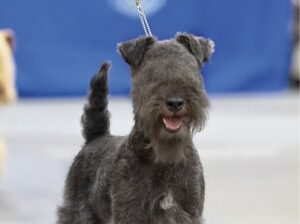
Insights from the 2022 MCKC Breed Judge Eva Fekete. Read about the judge’s opinions on various topics regarding the Terrier show.
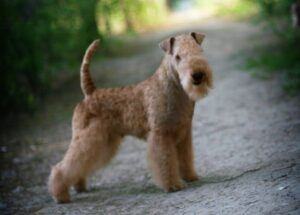
The Lakeland Terrier headpiece is unique. Not every Lakeland Terrier shown or finished will possess the ideal head, ears, and expression.
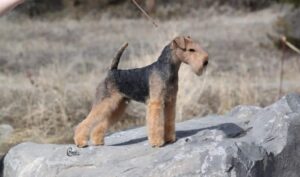
Lakeland Terriers come in more colors than any other Terrier breed; ten of them! Solid color black, blue, liver, red, and wheaten.
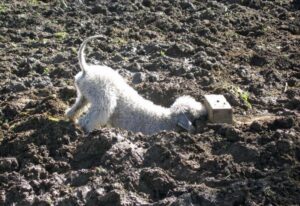
NATIONAL EARTHDOG TESTS hosted by the Bedlington Terrier Club of America, Monday (Columbus Day) October 10, 2022. Ev-ry Place, LLC., 1333

Explore the fascinating history, character, and unique traits of the Lakeland Terrier, a breed shaped by necessity and determination.

Patricia Harbison is the breeder behind Clifftops Lakeland Terriers. Read about the kennel’s beginnings, Lakeland Terrier puppies, and more!

Insights from the 2022 MCKC Breed Judge Eva Fekete. Read about the judge’s opinions on various topics regarding the Terrier show.

The Lakeland Terrier headpiece is unique. Not every Lakeland Terrier shown or finished will possess the ideal head, ears, and expression.

Lakeland Terriers come in more colors than any other Terrier breed; ten of them! Solid color black, blue, liver, red, and wheaten.

NATIONAL EARTHDOG TESTS hosted by the Bedlington Terrier Club of America, Monday (Columbus Day) October 10, 2022. Ev-ry Place, LLC., 1333
The best way to ensure a long and happy relationship with a purebred dog is to purchase one from a responsible breeder. Not sure where to begin?
Contact the National Parent Club’s Breeder Referral Program, which is listed on the AKC Breeder Referral Contacts page.
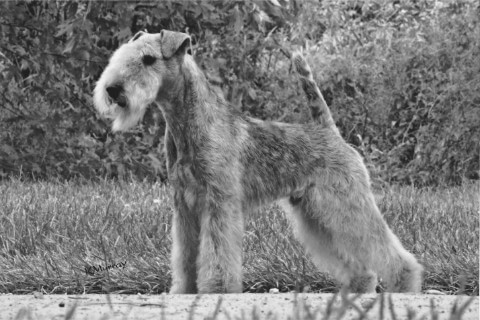

"*" indicates required fields
Showsight Magazine–the world’s most influential purebred dog publication since 1992. Each issue reaches a global audience dedicated to preserving the history and health of purpose bred dogs. Filled with award-winning editorial focused on news and insights from the dog show community, top breeders, handlers, AKC Judges, and more!